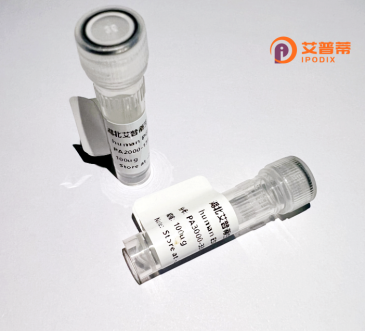
| 纯度 | >90%SDS-PAGE. |
| 种属 | Human |
| 靶点 | AYP1 |
| Uniprot No | Q8TDP1 |
| 内毒素 | < 0.01EU/μg |
| 表达宿主 | E.coli |
| 表达区间 | 1-164aa |
| 氨基酸序列 | MESGDEAAIE RHRVHLRSAT LRDAVPATLH LLPCEVAVDG PAPVGRFFTP AIRQGPEGLE VSFRGRCLRG EEVAVPPGLV GYVMVTEEKK VSMGKPDPLR DSGTDDQEEE PLERDFDRFI GATANFSRFT LWGLETIPGP DAKVRGALTW PSLAAAIHAQ VPED |
| 分子量 | 44.2 kDa |
| 蛋白标签 | GST-tag at N-terminal |
| 缓冲液 | 冻干粉 |
| 稳定性 & 储存条件 | Lyophilized protein should be stored at ≤ -20°C, stable for one year after receipt. Reconstituted protein solution can be stored at 2-8°C for 2-7 days. Aliquots of reconstituted samples are stable at ≤ -20°C for 3 months. |
| 复溶 | Always centrifuge tubes before opening.Do not mix by vortex or pipetting. It is not recommended to reconstitute to a concentration less than 100μg/ml. Dissolve the lyophilized protein in distilled water. Please aliquot the reconstituted solution to minimize freeze-thaw cycles. |
关于“重组人(AYP1)蛋白”的具体研究,当前文献数据库中未找到直接相关的记录。可能的原因包括:
1. **名称拼写错误**:如“AYP1”可能为基因或蛋白的缩写(例:AYP1可能指Arabidopsis Ypt/Rab GTPase homolog protein 1.但主要在植物中研究)。
2. **研究热度较低**:该蛋白可能尚未在人类中被广泛研究,或存在其他命名方式(如“AIP1”“YAP1”等)。
3. **应用领域特殊**:可能属于特定行业(如工业酶)或专利技术,未在公开文献中发表。
若研究方向无误,以下为可能的扩展建议:
- 检索 **UniProt** 或 **NCBI Protein** 数据库,验证蛋白标准命名。
- 尝试关键词扩展,如“recombinant AYP1 human”“AYP1 gene expression”。
- 若涉及未公开研究,建议联系相关生物技术公司或专利平台。
如需替代性文献主题(例如常见重组蛋白研究),可进一步提供调整建议。
Recombinant human AYP1 protein is a genetically engineered version of the naturally occurring AYP1 (Associated Yippee Protein 1) found in humans. AYP1 belongs to the Yippee protein family, which is evolutionarily conserved and implicated in metal ion binding, cellular differentiation, and developmental processes. The human AYP1 gene, located on chromosome 11. encodes a protein with a conserved MSP (Metal-binding, STAS domain, and P-loop) domain, suggesting roles in metal homeostasis or redox regulation. Studies indicate that AYP1 may interact with zinc or copper ions, potentially influencing enzymatic activities or stress responses.
Recombinant AYP1 is typically produced using bacterial (e.g., *E. coli*) or mammalian expression systems, enabling large-scale purification for functional studies. Its production allows researchers to investigate AYP1’s biochemical properties, structural characteristics, and interactions with cellular partners. Interest in recombinant AYP1 spans basic research—unraveling its physiological roles in cell proliferation, apoptosis, or neurodevelopment—and applied fields, such as exploring its potential as a biomarker for diseases linked to metal dysregulation (e.g., neurodegenerative disorders). Additionally, engineered AYP1 variants are used to dissect structure-function relationships or develop therapeutic candidates targeting metal-associated pathologies. Ongoing research aims to clarify AYP1’s mechanistic contributions to cellular pathways and its relevance in human health and disease.
×